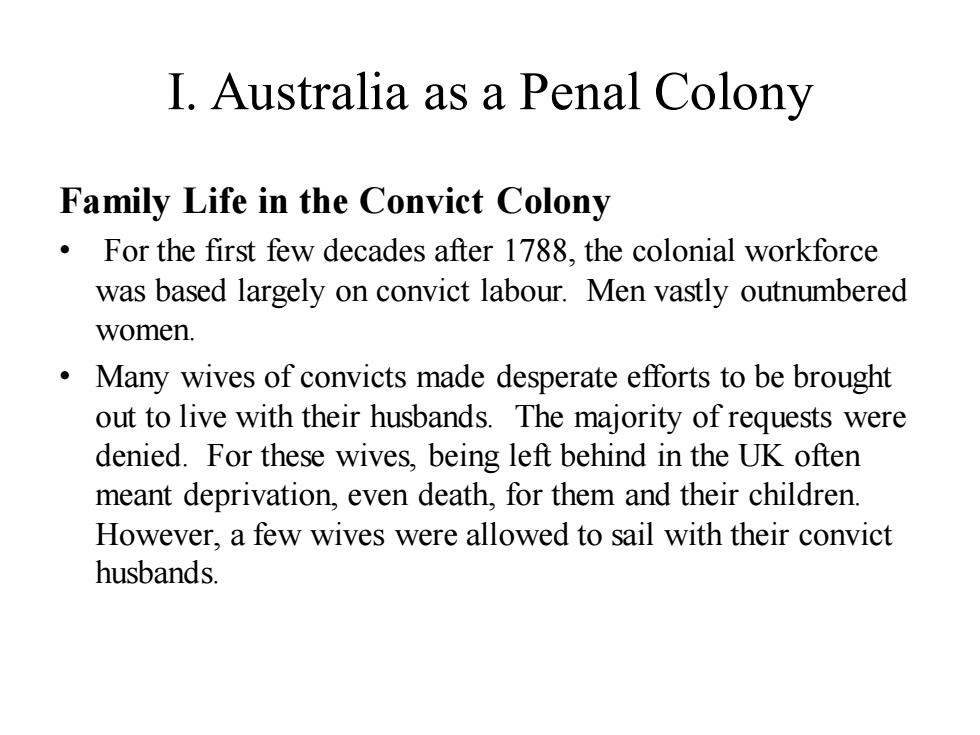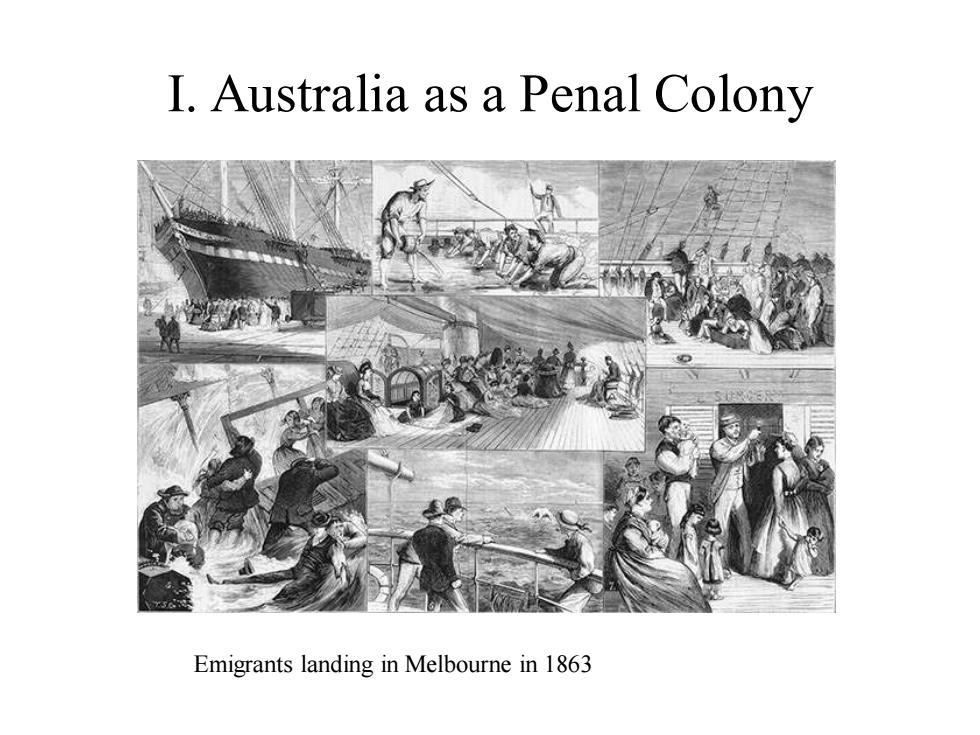
I.Australia as a Penal Colony Family Life in the Convict Colony For the first few decades after 1788,the colonial workforce was based largely on convict labour.Men vastly outnumbered women. Many wives of convicts made desperate efforts to be brought out to live with their husbands.The majority of requests were denied.For these wives,being left behind in the UK often meant deprivation,even death,for them and their children. However,a few wives were allowed to sail with their convict husbands
I. Australia as a Penal Colony Family Life in the Convict Colony • For the first few decades after 1788, the colonial workforce was based largely on convict labour. Men vastly outnumbered women. • Many wives of convicts made desperate efforts to be brought out to live with their husbands. The majority of requests were denied. For these wives, being left behind in the UK often meant deprivation, even death, for them and their children. However, a few wives were allowed to sail with their convict husbands

I.Australia as a Penal Colony In the first decades new families were often formed in the colony in a brutal way.When a ship with women convicts or "free"women migrants docked,first the Government officials and senior officers,then the sailors and "free"working men were allowed to go on board to claim a woman as a servant and/or a concubine. Convicts could claim the remaining women.The women who were not claimed either slept on the streets or were sent to the “Female Factory'”-a prison in Paramatta. Single women were at risk of being abused,and this was part of the institutional culture of the colony.Single women were obliged to work and sleep with one man or bear the considerable risks of being shared between men
I. Australia as a Penal Colony • In the first decades new families were often formed in the colony in a brutal way. When a ship with women convicts or “free” women migrants docked, first the Government officials and senior officers, then the sailors and “free” working men were allowed to go on board to claim a woman as a servant and/or a concubine. • Convicts could claim the remaining women. The women who were not claimed either slept on the streets or were sent to the “Female Factory”—a prison in Paramatta. • Single women were at risk of being abused, and this was part of the institutional culture of the colony. Single women were obliged to work and sleep with one man or bear the considerable risks of being shared between men

I.Australia as a Penal Colony Emigrants landing in Melbourne in 1863
I. Australia as a Penal Colony Emigrants landing in Melbourne in 1863

I.Australia as a Penal Colony The Parramatta Female Factory,in the former penal colony of New South Wales,is located in the grounds of North Parramatta,New South Wales.It was one of 13 female factories in the colonies of New South Wales and Van Diemen's Land.The factory idea was a combination of the functions of the British bridewells,prisons and The entrance to the Parramatta workhouses. Female Factory
I. Australia as a Penal Colony • The Parramatta Female Factory, in the former penal colony of New South Wales, is located in the grounds of North Parramatta, New South Wales. It was one of 13 female factories in the colonies of New South Wales and Van Diemen’s Land. The factory idea was a combination of the functions of the British bridewells, prisons and workhouses. The entrance to the Parramatta Female Factory

I.Australia as a Penal Colony Many of the women and men,who had been transported as convicts,lived together and had children without having been officially married in church.In Australian terms,these were“de facto'”families. Convict partnerships were not the only form of family of this era.There were also free"families of people who came over with the transported convicts,families of soldiers or administrators of the colony or people who arrived as "free settlers".However,the majority of men in the early years of the colony did not have wives.The majority of men,of course,were also convicts
I. Australia as a Penal Colony • Many of the women and men, who had been transported as convicts, lived together and had children without having been officially married in church. In Australian terms, these were “de facto” families. • Convict partnerships were not the only form of family of this era. There were also “free” families of people who came over with the transported convicts, families of soldiers or administrators of the colony or people who arrived as “free settlers”. However, the majority of men in the early years of the colony did not have wives. The majority of men, of course, were also convicts